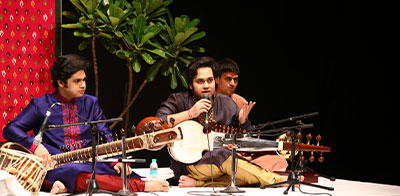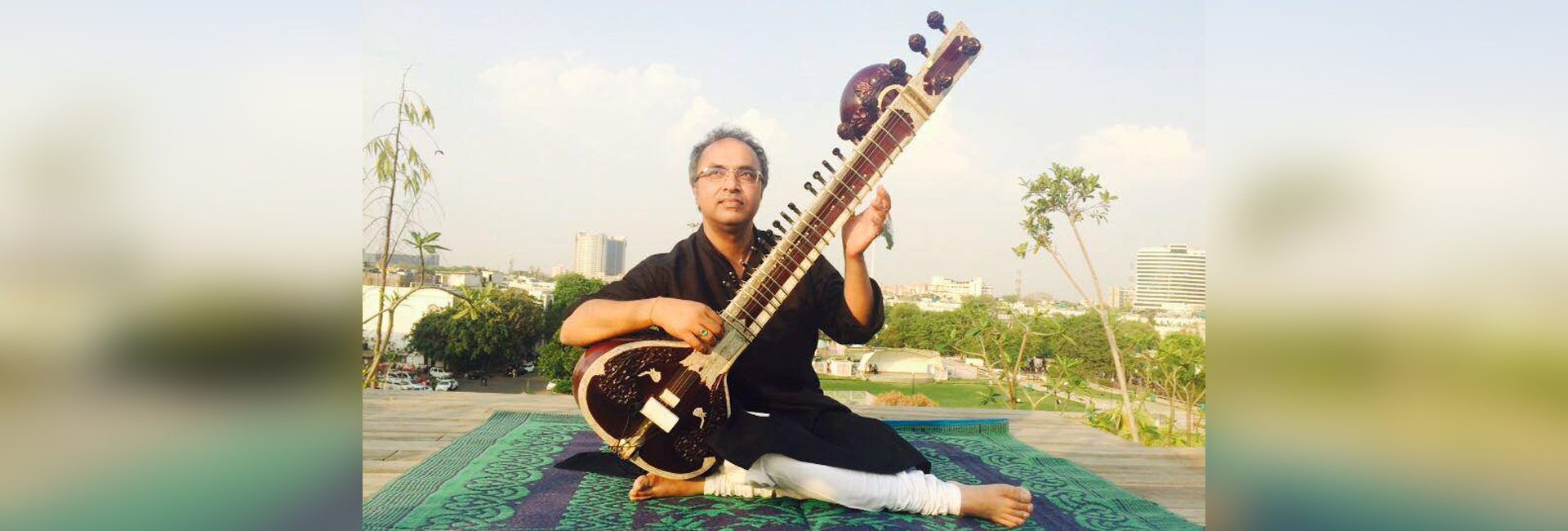(March 13, 2023) Back in January 2010, when the Mohan brothers — Lakshay Mohan and Aayush Mohan — were all set to give their first musical performance, they were informed in the last minute about the presence of Pandit Jasraj, the Hindustani Classical music legend, backstage. That such a revered musician would be witnessing their performance, set off butterflies in their stomachs. A few minutes into the ‘jugalbandi’, Lakshay (on Sitar) and Aayush (on Sarod) got so immersed in the sounds of music that all their worries vanished in a jiffy. Only a handful of musicians have taken Indian classical music to the global stage like the Mohan brothers – they were the first Indians to perform at the Grammy Museum in LA and have taken the stage at top venues around the world.
“Music allows you to express your inner self through the medium of pure sound, nurtures your creativity and therefore it never seems like a job,” say the renowned musicians, who have a super busy schedule this year. They begin the year in the UK and will embark on the North American Fall Tour in September-October, during which they would be performing at Columbia University, New York.
Their unique style enthralled the audience. So much so that Pandit Jasraj walked up to them on stage, blessed them and appreciated their performance. “Those were moments which will be forever memorable as it was our first major concert,” smile the Mohan brothers, in an exclusive conversation with Global Indian. Lakshay and Aayush, who have immense following among music lovers in India and abroad, have been performing globally since 2009. The first Indians to be invited to perform at the Grammy museum in Los Angeles, some of their prominent performances include Symphony Space, New York, Berklee College, Boston, Abbey Theatre, Dublin, David & Dorthea Garfield Theatre, San Diego among others.
The musical legacy
Hailing from New Delhi, Lakshay and Ashish’s father was an amateur Sitarist. “Our parents wanted us to take up classical music professionally. The thought of any other career never arose. Practising and learning music gave a sense of contentment and satisfaction,” say the brothers, for whom music was part and parcel of everyday life throughout their school and college life, music was their constant companion.
While Lakshay holds a Bachelor’s degree in Physical Sciences from the St Stephens College, Delhi, Aayush holds a Bachelor’s degree in Mathematics and Economics from the University of London. Both excelled in academics. From the very beginning, the Mohan brothers were attracted to the Maihar style of playing Sitar and Sarod, which are the flagship instruments of this Gharana.
Finding gurus
Initially, both started on the Sitar. Aayush always had a fascination for the Sarod’s deep and majestic sound. He tried his hand on the instrument and with the support of their guru, Pt. Balwant Rai Verma, he started learning it from Padmabhushan Sharan Rani. “She had trained under Baba Alauddin Khan Saheb who was the founder of Maihar Gharana. Like her guru, she was a very strict teacher who taught me in the old style,” says Aayush, who was only 11 at that time and handled the 13 kg instrument with difficulty.
He was also taught to change the strings of Sarod on his own. “This training helps me today to comfortably handle the situation when Sarod string breaks on stage during performance,” smiles Aayush. Renowned musician Pandit Umashankar Mishra once expressed his desire to listen to what Aayush h ad learnt. “When I played a composition, he was so impressed that he rewarded me with all the money that he had in his pocket. This was a traditional way of giving blessings. It was a very emotional moment and I still have those notes with me.”
Lakshay trained under Pandit Umashankar Mishra. “I used to get only 10 minute lesson and I had to practise it for 10 hours a day,” he recalls. Thereafter, both trained under Kolkata-based Pandit Tejendra Narayan Majumdar, one of the most popular classical musicians in the country. “He used to teach us continuously for four hours in the morning and again two to three hours in the evening. Next day we had to come with a night practice of 3 hours,” says Lakshay.

L.A. calling
In April 2015, the Grammy Museum, Los Angeles, was organising a year-long exhibition on music legend Pandit Ravi Shankar. The Mohan brothers were invited to perform on the opening day of the exhibition titled “Ravi Shankar : A Life in Music.”
“This concert saw us present some of the oldest Indian classical compositions to the western audience along with our collaboration with the American Cellist Barry Phillips,” say the Mohan brothers, who also performed a piece composed by Pandit Ravi Shankar as it was the opening of exhibition on his life and music.
The jugalbandi approach
Their musical repertoire is very traditional but they have redesigned their presentation which makes it better to connect with today’s listeners.
“Our Jugalbandi is an example of extensive coordination and a deep understanding of each other’s ‘musical vision. Practising and performing music together for almost 14 years now, it comes naturally to us,” say the renowned musicians, who will soon be finalising their album of ‘Malhars’ — the rainy season ragas that will have some of the most signature compositions of Maihar Gharana.
Both Sitar and Sarod being traditional instruments having its own unique sounds, they feel that the two are the most appropriate instruments to be paired up for a duet.
“We have been handed over a vast treasure of traditions enriched by great musicians by two generations of Gurus. For us, the goal is to bring to the listeners the pure quality of this music,” say the musicians, whose album “The Hidden Harmony” got nominated for Best Classical Instrumental award at the Global Indian Music Academy (GIMA) Awards 2016. The album was a recording of a Live Concert held at Abbey Theatre in Dublin in 2015.

Challenges
What kind of challenges do they face when performing live ? “On stage, we have to understand what the person is trying to convey during the musical dialogue or a sawal-jawab sequence and improvise instantly on a similar theme,” explain the Mohans, who have also been nominated for the Global Indian Music Academy awards for Best Classical Instrumentalists.
The Mohan brothers believe that both artists in a duet must be on an equal level. “Neither of them should appear to be playing like a soloist or an accompanist. We indulge in a playful competition on stage but at the same time have high respect for each other.”
They say that the choice of Ragas and it’s duration is often decided by the nature of audience at the concert. “If most of the people in audience are new to classical music, then it is better not to play any Raga for too long,” explain the maestros, who have given lecture-demonstrations at various universities including Wayne State University, Detroit and the University of Arts, Philadelphia.
Lakshay says the Indian classical genre unlike any other form, has the beautiful part, which is spontaneous presentation of a raga. “So our thinking process never gets saturated and we always see new horizons while playing a raga,” he says.
Passion to perform

“Over the years, we have realized that the real joy is to find what you connect to the most and be able to follow it, perfect it and grow closer to it passionately throughout life,” elaborates Aayush.
Among the many highlights of their musical journey has been performing with Anoushka Shankar and other disciplines of Pandit Ravi Shankar at the iconic Royal Festival Hall, London to celebrate his 100th anniversary. “It was a very special experience for us as we composed few fresh pieces which were added to his old composition in his Raga Tilak Shyam,” say Mohan brothers.
When not immersed in music, what do Mohan brothers like to do ? “I am passionate about cars and love going on long road trips and try new cuisines,” says Lakshay. As for Aayush, he likes to indulge in painting, creative designing and audio mastering, besides reading about history and archeological facts.


